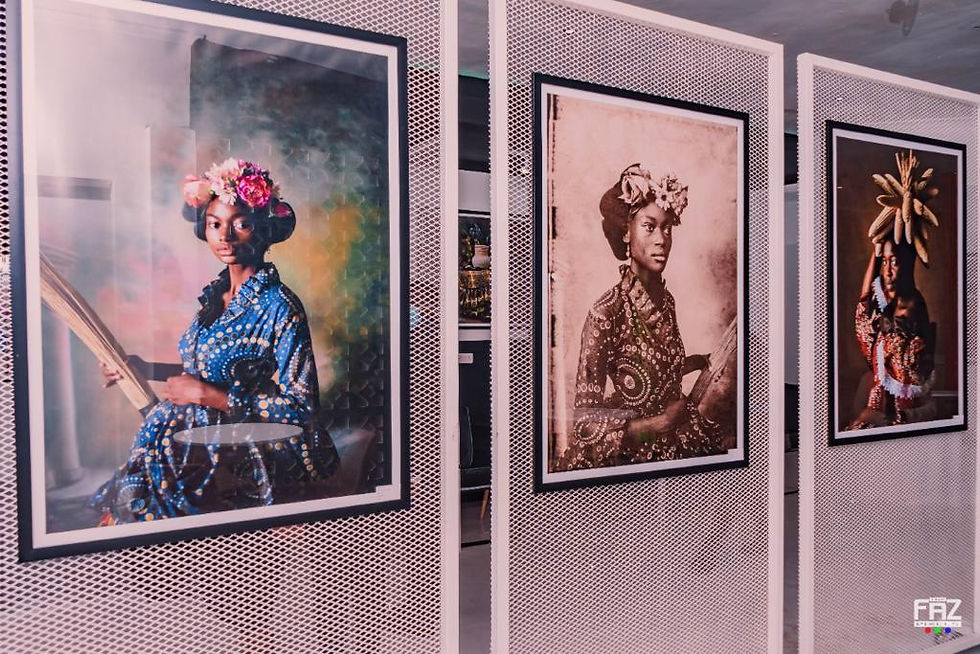Roots & Routes AFRICA ON DISPLAY: PAST, PRESENT, AND FUTURE
- Tinashe Chiura
- Aug 17, 2022
- 3 min read
Updated: Aug 19, 2022
by Tinashe Chiura

Tamary Kudita, That evening sun goes down, Photograph, 2020 (image courtesy of the artist)
Blackness is often synonymous with victimhood - in fine art, in historical retelling, and in our daily discourse. The influence of the colonial has permeated even the most indigenous spaces, making us as Black people rethink our value, and dim our own light in the face of an encroaching Whiteness. The Kudita sisters paint a portrait of the African as valid, as revered, and as beautiful.
Natasha Kudita’s block-like abstractions of familiar scenes invite the viewer to look deeper, to see beyond what we often do - daily life in screaming colour. Particularly at a time when it feels we have less and less time on our hands, where our lives seem to melt into a kind of blur, Natasha freezes for us the essence of the quotidian.
My initial reaction when seeing the Kuditas’ work was of admiration, but a distanced kind. Upon greater time spent with the images and artworks, I came to see that there are some works with which one neds to really spend time in order to see beyond their initial splendour, to the depth of meaning and symbolism that lies within. Such is the case with Tamary Kudita’s photographs.
As a photographer myself, I went through a small mental checklist of analysis at the PIKICHA opening; where is the light coming from, what numerical elements exist here, how are the subjects posed, what am I reminded of, what iconographies are here, etc.

installation shot - Natasha Kudita, Musika (image courtesy of the artist and Fazpixels)
One of the most striking elements of Natasha Kudita’s abstract illustration, ‘Musika’, is the presence of a central figure. Anchoring the image amongst a milieu of movement, Kudita allows the viewer to imagine ones own presence in the hustle and bustle of the everyday musika.
The visual language of light is not to be overlooked in the realm of photography, however the ways in which we use, decode, and place emphasis on light can have profound effects on how a photograph is perceived. In the case of “The Gathering” I was led to ask why the women were in black, why there were six of them, and what style the thatching of the hut was. There is an obvious painterly influence in these photographs that only adds to its nod to antiquity, though it cannot be denied that the stylisation of Tamary’s images emphasises a detachment from the history itself; some are indicative of rupture.

installation shot - Tamary Kudita Victorian Series (images courtesy of artist and Fazpixels)
Both of the Kudita sisters have eloquently subverted the erasure of blackness in eras both modern and ancient, bringing beauty, complexity, and artistryto their pieces. Tamary’s visualizations of maternity, an omnipresence of unflinching womanhood in the images’ strength of cultural iconography is coupled with an undeniably soft image quality, and Natasha urges for the viewer to look deeper into the quotidian in its fragmented shapes and colours.
PIKICHA gallery is undoubtedly the new place to be for contemporary artists exhibiting both at home and abroad. The open layout and exuberant energy in blacks and greens gives one the undeniable feeling that this is a space where art is made, shown, lived, and experienced. The Kuditas’ exhibition ran until 15 August 2022.
Tinashe Chiura is an artist, writer and host of Balance Me Podcast
Exhibition Opening photographs by Fazpixels





































Comments